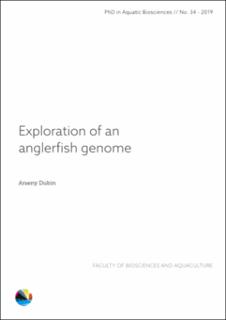| dc.contributor.advisor | Johansen, Steinar Daae | |
| dc.contributor.advisor | Jakt, Lars Martin | |
| dc.contributor.author | Dubin, Arseny | |
| dc.date.accessioned | 2020-11-10T07:42:34Z | |
| dc.date.available | 2020-11-10T07:42:34Z | |
| dc.date.created | 2019-12-02T03:22:14Z | |
| dc.date.issued | 2019 | |
| dc.identifier.citation | Dubin, A. (2019). Exploration of an anglerfish genome (Doctoral thesis). Nord University, Bodø. | en_US |
| dc.identifier.isbn | 978-82-93165-33-0 | |
| dc.identifier.uri | https://hdl.handle.net/11250/2687015 | |
| dc.description | Doctoral thesis (PhD) - Nord University, 2019 | en_US |
| dc.description.abstract | The anglerfishes comprise an extremely diverse order of teleosts with unique adaptations. The most notable is sexually parasitism of reproduction where the male attaches to the female. This can result in fusion of two genetically distinct organisms, which would in most vertebrate species result in an immune rejection. However, in sexually parasitic anglerfish fusion occurs with no immune rejection. The mechanisms that have allowed the evolution of such adaptations are of interest not just to evolutionary biology, but perhaps also to biomedical research related to the prevention of allogenic rejection after transplantation. Nevertheless, anglerfishes remain poorly understood. In this project we have produced the first chromosome level assembly of an anglerfish (Lophius piscatorius). We also provide an annotation of this genome based on orthology inference and believe that this will provide a comprehensive genetic resource for the study of anglerfish biology facilitating research addressing the evolution of anglerfish specific properties. As part of an analysis of the initial contig level assembly we characterized the L. piscatorius mitochondrial genome and transcriptome. This identified low-level heteroplasmic sites, a species-specific control region indel, as well as a novel long non- coding RNA derived from the Cytochrome Oxidase I locus. Furthermore, we observed a remarkable sequence conservation of the mitochondrial-derived peptide Humanin. These findings contribute to our understanding of mitochondrial regulation and function, and are of interest not only to anglerfish research. It is thought that sexual parasitism has evolved independently multiple times within the Ceratioidei suborder, suggesting that they may share a common genetic predisposition that facilitates sexual parasitism. As the removal of immune rejection is a requirement for the fusion of two individuals it is possible that this predisposition arises from a modified immune system that may be shared with the non-parasitic anglerfish taxons. Given that two teleost taxons (Gadiformes and Syngnathus) have previously been reported to lack the MHC II arm of the adaptive immune system we made use of the initial draft genome assemblies to establish the absence or presence of MHC II in L. piscatorius. Surprisingly we found an absence of exactly the same five (of 30 assayed) genes absent in Gadiformes. This observation implies that these five genes (CD4, CD74 A/B, MHCIIα/β) comprise a core set of MHCII genes that have no essential functions external to MHC II, and suggests the possibility that loss of MHCII may have been one of the events that enabled the development of sexual parasitism in anglerfish. To annotate the final chromosome level assemblies, we made use of in silico gene predictions supported by evidence from RNA followed by an orthology based functional annotation. An analysis of the resulting annotation confirmed that L. piscatorius has a fairly typical teleost genome in terms of genome size, global gene repertoire and gene feature composition. We also observed a chromosomal orthology with several teleost species that argues that the scaffolds reported here do indeed represent physical chromosomes. These analyses also revealed a teleost specific bimodality in intron length distribution that could be correlated to genome size within the teleosts, suggesting a coupling between the mechanisms governing intron and genome size in teleosts. The work presented in this thesis not only provides new genome resources that should facilitate further research into the weird and wonderful world of the anglerfishes, but also confirms an unexpected plasticity in teleost adaptive immunity. Surprisingly we were also able to observe fundamental genome properties related to intron size that have not previously been reported. Our work thus touches not only on the specifics of teleost immunology but also on general mechanisms underlying genome evolution in the teleosts. | en_US |
| dc.language.iso | eng | en_US |
| dc.publisher | Nord University | en_US |
| dc.relation.ispartofseries | PhD in Aquatic Biosciences;no. 34 | |
| dc.relation.haspart | Paper I: Dubin, A., Jørgensen, T. E.M, Jakt, L. M., Moum, T. & Johansen, S. D. (2017). The mitochondrial genome of the European anglerfish Lophius piscatorius. Express low-level substition heteroplasmy. Annals of Marine Biology and Research, 4(1), 1019. Available online: http://www.jscimedcentral.com/MarineBiology/marinebiology-4-1019.pdf. Fulltext is not available in Nord Open. | en_US |
| dc.relation.haspart | Paper II: Dubin, A., Jørgensen, T. E., Jakt, L. M. & Johansen, S. D. (2019). The mitochondrial transcriptome of the anglerfish Lophius piscatorius. BMC Research Notes, 12: 800. doi: 10.1186/s13104-019-4835-6. Fulltext available in Nord Open: https://hdl.handle.net/11250/2658229 | en_US |
| dc.relation.haspart | Paper III: Dubin, A., Jørgensen, T. E., Moum, T., Johansen, S. D. & Jakt, L. M. (2019). Complete loss of the MHC II pathway in an anglerfish, Lophius piscatorius. Biology Letters, 15(10), suppl. 20190594. doi: 10.1098/rsbl.2019.0594. Fulltext available in Nord Open: https://hdl.handle.net/11250/2658241 | en_US |
| dc.relation.haspart | Paper IV: Dubin, A., Jørgensen, T. E., Moum, T., Johansen, S. D. & Jakt, L. M. (Forthcoming). Assembly and annotation of an anglerfish genome. Fulltext is not available in Nord Open. | en_US |
| dc.relation.haspart | NB: Lenker til artiklene oppgis kun dersom disse er tilgjengelige i arkivet. | en_US |
| dc.title | Exploration of an anglerfish genome | en_US |
| dc.type | Doctoral thesis | en_US |
| dc.description.version | publishedVersion | en_US |
| dc.rights.holder | © Arseny Dubin, 2019 | en_US |
| dc.subject.nsi | VDP::Marinbiologi: 497 | en_US |
| dc.subject.nsi | VDP::Marine biology: 497 | en_US |
| dc.subject.nsi | VDP::Matematikk og Naturvitenskap: 400::Basale biofag: 470::Genetikk og genomikk: 474 | en_US |
| dc.source.pagenumber | 173 | en_US |
| dc.identifier.cristin | 1755170 | |
